Introduction
Photos of ponds packed with eagerly feeding fish are capturing the imagination of people across the country. Before jumping into fish farming, however, it is wise to temper your enthusiasm with an objective look at the benefits and disadvantages involved. It is not unusual for people interested in aquaculture to have some mistaken ideas (Table 1).
Table 1. Some common myths about aquaculture.
|
Fiction |
Fact |
|
| Any fish or aquatic animal can be economically raised on a fish farm. | Most cannot be. Lack of control over reproduction and nutrition, make the farming of many desirable species impractical at present. | |
| I can find a site for a fish farm on my property. | Most sites are unsuited for fish farming because they lack adequate water or proper soils for pond construction. | |
| Fish farming is relatively easy. | Fish farming is agricul- ture and requires close management, hard- work and the ability to tolerate risk. | |
| Fish farming is very profitable. | As in other types of agriculture, the level of profit is seldom excessive. | |
| Fish farming is a good retirement activity. | Running a fish farm requires hard physical work and can be stressful. | |
| Fishing is a good background for getting into fish farming. | Farming is the best background for getting into fish farming. Basic farming skills like operating a tractor, equipment repair, and welding are needed. | |
What to Produce?
Most new fish farmers in Oklahoma plan to produce channel catfish, but many other types of fish and aquatic animals can also be considered. The discussion that follows is designed to allow you to consider some different species while pointing out the advantages and disadvantages of each. Some of these are included because they appear promising for Oklahoma conditions. Other species with poor potential are included only because many people are interested in them.
Bait Fish
 |
Oklahoma enjoys many large fishing lakes and is a major consumer of bait fish. Golden shiners, fathead minnows, and goldfish are among the most popular bait species and can be produced reliably in ponds. These species reproduce naturally and grow well on inexpensive feeds. A series of flat bottomed ponds that can be drained, seined, and refilled are needed so buyers can be supplied on a regular basis. If you are considering bait fish production you need to be aware that there are very large Arkansas producers wholesaling bait fish in Oklahoma. These producers have low production costs and will probably offer their fish at cheap prices if you attempt to compete with them directly. Further information on bait fish production is available in SRAC publications 120-122, available through the county extension center.
Channel Catfish
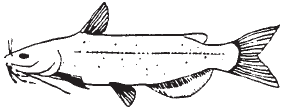 |
Catfish farming makes a significant contribution to the economies of many southern states, including Oklahoma. The channel catfish is preferred over other species of catfish because of its tolerance for handling, good feed conversion, high dress-out percentage, and ease of spawning. Flat bottomed ponds filled by well water are the ideal situation for catfish production, but watershed ponds and cages in lakes may also be used successfully. More complete information on Catfish Farming is contained in OCES Extension Fact Sheet NREM-9002 and the Langston University publication titled, “Is Fish Farming for Me?”
Crawfish
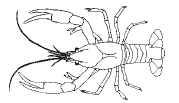 |
Production of crawfish has proven to be economical in Louisiana and Texas and interest has spread to other states. Larger crawfsh are prized as a gourmet food item while smaller ones are in demand as bait. Red swamp crawfish are the traditional species to culture. The green pond crawfish (Orconectes nais) is being experimented within Kansas and looks promising for Oklahoma as well. Because the green pond crawfish does not burrow during the summer it enjoys a longer growing season than does the red swamp crawfish.
The economic feasibility of crawfish production under Oklahoma conditions has not yet been fully demonstrated. Requirements include relatively flat land with good water holding capacity and enough water to maintain 1 1/2 to 2 feet of water depth. Much labor is needed to harvest and reset traps each day for four to seven months out of the year. Further information on red swamp and green pond crawfish culture are available in the OCES information sheet titled, “Crawfish Update.”
Australian crawfish, advertised as “marron” or “freshwater lobster,” have been available for several years in this country. To the best of the author’s knowledge, no commercially successful production has been achieved. Such exotic crawfishes are likely to be susceptible to the widespread crawfish fungus plague, to which our native species are apparently resistant.
Frogs
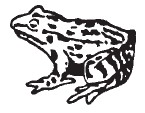 |
Frogs are in demand both as food and for biological research. The frog legs you see in the market are from wild frogs coming from as far away as Bangladesh. Frog farming is highly experimental. Each growth stage requires close attention and a different type of production facility. Adult frogs are reported to consume food only if it is moving. This has led to some extremely innovative and labor intensive methods, including the dangling of food pellets from horsehair. Unconfirmed reports say that frog farming may be feasible in Brazil, where labor costs are low.
Hybrid Striped Bass
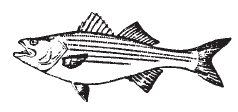 |
Demand for striped bass and hybrid striped bass is high, especially on the east coast where the wild catch is declining and pollution problems worry consumers. The cross between white and striped bass has proven to be an excellent fish for pond and tank culture. Unfortunately, problems remain to be solved in the production of fingerlings. Until a reliable supply of fingerlings is available, caution is advised. Further information on hybrid striped bass fingerling and food fish production is available in SRAC publications 302 and 303, available through your county extension center.
Paddlefish
 |
Interest in paddlefish or “spoonbill” culture is mainly due to prices of $30 or more per pound for its eggs, which are substituted for Iranian and Russian caviar. The flesh has only a small value at present, but is very fine for smoking. Paddlefish culture is experimental so the level of investment should be kept low. Approximately ten years are required before a female will produce eggs. Paddlefish feed by filtering very small animal life from the water. A production system that appears promising is to culture paddlefish in catfish ponds for two to three years and then stock them in large ponds or lakes for later capture by commercial fishing techniques. This has not yet been tested. There are a few paddlefish fingerling producers but production is not reliable. Paddlefish fingerlings are reported to be very susceptible to birds due to their habit of swimming near the surface.
Shrimp
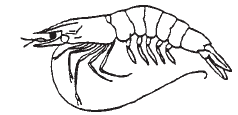 |
Marine penacid shrimp are a luxury food for which Americans seem to have an ever growing hunger. To help satisfy this hunger, major corporations and private investors have built large shrimp farms in Central America, South America, and Asia where the tropical climate is favorable. Oklahoma’s climate is not suited for penaeid shrimp, which cannot tolerate temperatures below 60°F. Indoor tank culture using heated water appears impractical due to problems with cannibalism.
A species of freshwater shrimp, Macrobrachium rosenbergii, grows well at temperatures above 68°F and salinities of up to eight parts per thousand. Heads are much larger than on marine shrimp and the flesh may be softer than marine shrimp, leading to some marketing difficulties. Because death occurs at temperatures below 50°F, commercial potential for this species in Oklahoma is very poor. Cannibalism makes indoor tank culture of freshwater shrimp impractical.
Sport Fish and Forage Fish Fingerlings
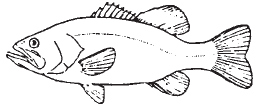 |
Production of bass, bluegill, hybrid bluegill, and other fingerlings for stocking in private fishing ponds is a proven form of aquaculture that has been practiced in Oklahoma for decades. Additional species that can be produced as forage for bass include shad and minnows. Production of these species involves natural spawning of brood stock in ponds, removal of brooders and rearing of fingerlings in place. Because the production of fingerlings requires much care and skill, it is not recommended for those without experience gained by producing food fish. Further information on largemouth bass and forage fish culture can be found in SRAC publications 200-201 and 140-142.
Tilapia
 |
Originally found in Africa and the Near East, many different species of tilapia have been introduced around the world because of their suitability for aquaculture. Tilapia species have an excellent quality flesh that many people compare to crappie, are tolerant of poor water quality conditions, and grow well on low protein feeds. The leading technical problem in culturing tilapia is that they die when temperatures drop to about 50°F. Because of this, brood stock or fingerlings must be overwintered in heated indoor tanks or small ponds fed by naturally warm well or spring water. Another serious problem is frequent reproduction. This leads to overpopulated ponds and stunting if left uncontrolled. A promising species for culture is the cross between female Nile tilapia (chromis niloticus and male blue tilapia (Oreochromis aureus). Fish from this cross are almost all males, so unwanted reproduction is avoided. Further information is available in SRAC publications 280-282.
Trout and Salmon
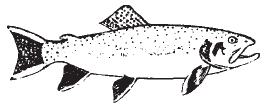 |
Culture of trout is a major form of aquaculture in Idaho and Missouri but only rarely done in Oklahoma. Salmon farming is well developed in Norway, Scotland, and Chile but still in its beginning stages in the U.S. These cold water fish generally grow best at water temperatures between 55 and 65°F and die when temperatures approach 70°F. Water that meet this requirement year-round in Oklahoma is scarce. Culture of rainbow trout in ponds during the winter months has been demonstrated and is described in the Langston University publication, “Cage Culture of Rainbow Trout”. Because the number of Oklahomans familiar with trout is limited, some producers wisely take orders for trout before they purchase fingerlings. Studies are currently being conducted to determine the potential for winter culture of salmon in Oklahoma.
What Production System To Use?
Most fish in the U.S. are produced in smooth bottomed ponds filled by wells that produce on the order of 1,000 gallons per minute. Because such water resources are rare here, Oklahoma fish producers look to a variety of different production systems. The production system that is best for your situation will depend on the water source available. Existing lakes and ponds are often suitable for cage culture. Wells, reservoirs, and creeks can be used to fill smooth bottomed ponds. Springs or gravity flow from a reservoir can be used for continuous flow tanks and raceways.
Cages
Cage culture involves stocking fingerlings in floating cages and then feeding them a nutritionally complete diet. Fish that will take feed pellets are usually suitable for culture in floating cages. This includes channel catfish, rainbow trout, tilapia, and striped bass. The major advantage of cage culture is that it requires much lower start-up costs than other production systems. Cages work well for many people on a small scale, but they have several problems that need to be understood before making a major investment.
The choice of pond or lake is critical. Avoid ponds that are smaller then one surface acre, very deep, or more than one-third covered by water plants. Also avoid ponds that have a deep green color due to large amounts of microscopic plants known as phytoplankton.
The amount of fish produced must be kept low. If more than 1,000 pounds of fish are produced per surface acre of pond or if more than 30 pounds of feed per surface acre per day is fed, then fish are likely to die due to lack of oxygen.
Diseases can spread quickly through a cage of fish and are difficult to treat with chemicals. Because of this, many small cages are recommended over a few large cages. Stress induced diseases are common when fish are held in cages through the winter months making year-round production difficult.
Algae (“moss”) or freshwater sponges sometimes grow on cages requiring tedious cleaning with a push broom.
To be successful, cage operations must be run by a good manager who understands all of the points above plus regularly monitors water quality conditions in their lake so problems can be anticipated m advance. Once water quality deteriorates in a lake to the point where fish are dying, it is usually too late to do anything. Good feed, top quality fingerlings and the right water body are essential for cage culture. Further information on cage culture is available in SRAC publications 160-165, available through your county extension center and in the Langston University publications titled, “Small Scale Caged Fish Culture” and “Caged Catfish Culture Problems”.
Ponds
Pond culture involves stocking fish in specially designed ponds filled with standing water. It is a well proven and reliable means of fish production when properly managed. Essentially all species suitable for aquaculture can be grown in standing water ponds. Ponds have generally proven to be the most economical means of producing fish and the way to get the most fish production per unit of available water.
Waste produced by fish remains in the pond where it is broken down by phytoplankton and bacteria. If fish are stocked and fed intensively, levels of waste can be high, leading to excessive growth of algae and periodic low oxygen levels. Smooth bottomed ponds, designed for fish culture, cost from $2,000 to $3,000 per surface acre to construct. Such ponds are used to produce between 2,000 and 5,000 pounds of fish per surface acre per year depending on species and level of management. If the water source is a spring or well, a minimum of 13 gallons per minute of flow per surface acre is required. When the water supply is a reservoir, it should have at least at least three times the storage capacity of the pond it is intended to fill.
As in cage culture, a regular program of monitoring dissolved oxygen and other water quality variables is essential, but pond cultured fish can survive many water quality problems that would kill caged fish.
Continuous Flow Systems
Raceways, tanks, or ponds through which new water flows constantly are known as continuous flow systems. Raceways are long channels generally made of concrete or else built by simply moving earth. Tanks are usually built from fiberglass or concrete. They may be either rectangular or circular in shape. Producing large amounts of fish in such systems is technically proven but uneconomical in many situations. Trout are the most common fish produced in continuous flow systems, but most species of cultured fish will also do well.
Recirculating System
Indoor tank systems in which water is filtered and reused are known as recirculating systems. The most common species that people attempt to culture in these systems are tilapia and catfish. Recirculating systems hold the promise of year round fish production both in locations close to major markets and where water supply is limited. They have been under development for approximately 20 years but should still be considered highly experimental. The crux of the technical problem lies in converting the wastes produced by fish to less toxic forms. Most systems rely on a filter bed of Nitrosomonas and Nitrobacter bacteria to accomplish this process. Unfortunately, these biofilters often die unexpectedly and can be killed by fish disease treatments. An intensive water quality monitoring program is essential, along with backup systems that can quickly flush new water through the system in an emergency. Unpleasant flavors are sometimes imparted to fish in these systems due to compounds produced by actinomycetes (fungi). There are many who believe that recirculating systems are the fish farms of the future, but very few who claim that they are feasible today.
Planning an Aquaculture Enterprise
By reading through the information above, you have considered a wide range of options. To narrow these down and finally arrive at a detailed plan for one production system, you will need to read as much information as you can and then visit with aquaculture Extension specialists and experienced fish farmers. As you do this, it will be helpful if you keep some key questions in mind (Table 2).
How Do I Sell What I Produce
The time to decide how to market your product is now, during the planning stages, not after you have a pond full of fish. Most Oklahoma fish farmers have more than one way to sell the fish they produce. Table 3 lists most of the marketing outlets you should consider. One successful strategy has been to sell as many fish direct to the consumer as possible and then use processors or wholesale buyers to get rid of the remainder.
Some fish farmers love to meet individual customers and enjoy trying to satisfy their demands. Others would rather not deal with people. Your like or dislike for working with individual customers has a major effect on which market outlets you should consider. The other major factor to consider is how much it will cost you to produce a pound of fish. To determine this make an enterprise budget that takes all production costs into account. You should consider more than just feed and fingerling costs. Assistance in preparing budgets is available from the sources listed at the end of this fact sheet. More information on how to market aquaculture products is contained in SRAC publication 350.
Table 2. Important questions to ask yourself when planning an aquaculture enterprise. If you answer “no” or “unsure” to a question, you should investigate further before investing significant money.
| Is the type of aquaculture I am considering tried and proven? | ||
| Yes | No | Unsure |
| Will it work in this climate? | ||
| Yes | No | Unsure |
| Do I have enough water? | ||
| Yes | No | Unsure |
| Does my site have suitable soils and slope? | ||
| Yes | No | Unsure |
| Am I good at raising animals? | ||
| Yes | No | Unsure |
| Am I able to perform hard physical labor from time to time? | ||
| Yes | No | Unsure |
| Do I have the skills needed to operate and maintain tractors or other needed equipment? | ||
| Yes | No | Unsure |
| Will I be able to handle the stress of losing large amounts of fish from time to time? | ||
| Yes | No | Unsure |
| If there is not an established market for what I plan to produce, am I willing to work with individual buyers? | ||
| Yes | No | Unsure |
| Is my estimated production cost low enough to allow a reasonable profit? | ||
| Yes | No | Unsure |
| Can I obtain the needed permits? (See OSU information sheet titled, “Permits and Regulations Affecting Oklahoma Fish Producers”) | ||
| Yes | No | Unsure |
| Is my personal or farm economic situation able to handle additional risk? | ||
| Yes | No | Unsure |
Table 3. Common outlets for aquaculture products and some relevant comments about them.
| Farm Sales Direct to the Consumer | If live fish are to be sold, holding vats are needed. If dressed fish are to be sold, a health permit is required. Customers will intrude at odd hours. | |
| Farmer‘s Markets | Hauling tank for pickup truck is usually needed. | |
| Grocery Stores | Fish must be processed. Competition from large processors is always a concern. | |
| Fee Fishing Operations | Fish must be in tip condition. Large fish may command higher prices. Hauling truck generally needed. | |
| Restaurants | Fish must be processed. Uniform portions and regular supply are required. Danger of competition from large processors. | |
| Processors | Will accept large quantities but generally pay the lowest price of any buyer. | |
| Fish Live Haulers | Usually deal only with large established farms. | |
Financing an Aquaculture Enterprise
Outside of the major catfish producing regions of Mississippi, Arkansas, and Alabama, financing for aquaculture is difficult to obtain. The most successful strategy for most people is to use personal funds to operate a pilot project for several years. Financial records from this operation can then be used as the foundation for a business plan submitted to a bank. Information on how to produce an aquaculture business plan is available from the OCES Aquaculture Specialist listed at the end of this publication.
At the time of publication, low interest rate loans earmarked for alternative agriculture were available to Oklahoma farmers through the Ag-Link loan program. Information on this program is available through your OCES county extension center. In addition, loans for aquaculture are possible through the Small Business Administration (SBA) and the Farmers Home Administration (FmHA). Local commercial banks are your contact for obtaining Ag-Link and SBA loans. FmHA makes loans only when you are unable to get credit from other sources at reasonable rates.
Some Final Advice
In the course of working with hundreds of people interested in starting aquaculture enterprises, the author has arrived at two pieces of advice that he would like to pass along to you now.
Imitation, not innovation, is the key to success for beginning aquaculturists. A proven species and type of production facility is almost always the best choice. Few new fish farmers can afford the time or money needed for experimental systems.
Start small and learn as grow. No matter how well you plan your aquaculture enterprise, you will learn a great deal during your first few years of operation. Starting small will allow you the flexibility to improve your facilities and time to develop your markets while minimizing your risk.
May 2007

